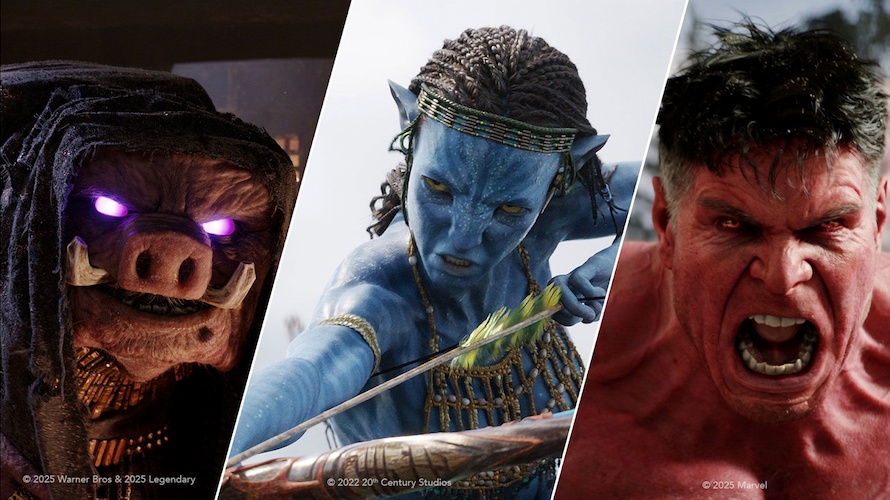Animating the Impossible: How Wētā FX Brings Marvel, Avatar, and Minecraft to Life
At Annecy 2025, Wētā FX opened the curtain on its distinctive storytelling process, demonstrating how its animation team goes beyond execution to become creative partners in shaping some of Hollywood’s most ambitious films. The panel, moderated by Wētā FX marketing manager Inge Rademeyer, featured Annie Award-winning supervisors Sidney Kombo-Kintombo and Kevin Estey, whose work spans Avatar: The Way of Water, The Hobbit, The Avengers, and the newly released Minecraft movie.

Four Scenarios of Animation Involvement
The talk broke down Wētā’s collaborative workflow into four core scenarios, each reflecting a different level of creative integration between animators and filmmakers.
Scenario 1: Animation Execution
This is the most traditional animation role—delivering on a director’s vision based on previs or template footage. These templates can be rigid (referred to as "the Bible") or loosely defined, and animators must remain flexible while interpreting the intent behind the performance. Key examples included:
- Refining motion capture in Avatar: The Way of Water and War for the Planet of the Apes, where animators add detail beyond the raw capture, including intricate elements like jewelry, facial expressions, or infant characters
- Keyframing entire sequences, such as one from Avatar, where nothing existed outside the animators' input
- Solving live-action inconsistencies, as in Infinity War, where Spider-Man’s fight with Thanos evolved from minimal previs into a fully built action beat driven by animation and camera fluency
Estey emphasized that while performance capture is a powerful tool, Wētā treats it as just the first step. As he put it, “We are an animation studio that uses performance capture—not a performance capture studio that does animation."
Scenario 2: Motion & Character Development
When clients come to Wētā without a clear blueprint for how a character should move, the studio helps define their physical identity. One standout example was Eternals, where speedster Makkari’s motion initially fell short of expectations. Wētā devised an approach where the character’s speed is felt as much as seen—appearing too fast to track, hitting with the force of multiple versions of herself. Marvel Studios liked the idea so much, they invested in reshoots to bring the effect to life.
Character creation also took center stage in the Minecraft movie, including the development of Malgosha, a piglin sorceress who serves as the film’s antagonist. As a wholly original character not found in the game, Malgosha had to fit seamlessly into a world beloved by millions. The team combined motion tests, reference footage, and performance capture with longtime collaborator Allan Henry to shape her quirky, terrifying presence.
Animators even gave personalities to background piglins, inventing nicknames like Snowball and Oinkiver to differentiate them in motion tests. Meanwhile, the mocap stage became a sandbox for exploration. If the space is free, animators can step in to experiment, play, and even generate a starting point for their shot—proving that some of the best ideas often come from just goofing around.
Scenario 3: Story Development
In cases where animators are brought in early, they help build scenes from the ground up. Wētā contributed the 10-minute cold open to Transformers: Rise of the Beasts from just four script pages. Kombo-Kintombo and Estey described workshopping fight choreography using iPhones and stunt performers, then applying that footage to digital previs with a real sense of editorial pacing and cinematography.
Another example came from Captain America: Brave New World, where the brief to animate Red Hulk began as a single sentence: “In a furious rage, the President turns into Red Hulk." That sentence became 60 shots. The filmmakers also requested a “King Kong moment," which the team visualized with internal storyboards, resulting in a fiery rooftop explosion atop the White House.
Scenario 4: The Oner – One Shot, Infinite Challenges
The most daunting scenario is “the Oner," where a director asks for a complex sequence to unfold in a single uninterrupted shot. One example came from Avengers: Endgame, where thousands of characters—some live-action, some digital—had to coexist in a fluid, cinematic battle.
Wētā’s team digitally erased problematic moments from the plate footage, such as a stunt actor sprinting out of frame. They transitioned between real and CG characters mid-shot, and created a massive crowd system in which the animation team focused on the hero characters while the background action was handled by the crowd department. Meticulous turnover planning ensured everything worked in sync, with animators using simple models and shapes to plan out camera movement, staging, and action beats.
A Culture of Creative Collaboration
At the heart of Wētā’s success is a culture that values problem-solving, experimentation, and storytelling. Their motion-capture stage isn’t just a technical tool—it’s a creative lab. Animators are encouraged to explore, collaborate with directors, and even jump into mocap suits themselves.
During the Q&A, the panel revealed that Wētā FX employs over 2,000 people globally, with about 160 in the animation department, supported by additional units for motion editing, crowd simulation, and facial systems. Scheduling mocap requires planning, but the proximity of the stage makes spontaneous creative sessions possible. The team admitted they sometimes lose sleep balancing creativity with tight deadlines, but a strong support system helps them rise to the challenge. A prime example: the 10-minute Transformers opener was completed in just three weeks—even while Estey was traveling for reshoots, with Kombo-Kintombo rallying the team back home to keep production moving.
The Wētā FX panel at Annecy 2025 offered a masterclass in how animation has evolved from a technical service into a central storytelling force. Whether refining existing scenes, inventing new motion, or helping shape entire sequences from scratch, the animators at Wētā are fully embedded in the filmmaking process. Their work may go unnoticed when done right, but it’s exactly that invisibility that defines their success.
Click here for more of our coverage from Annecy Festival.



